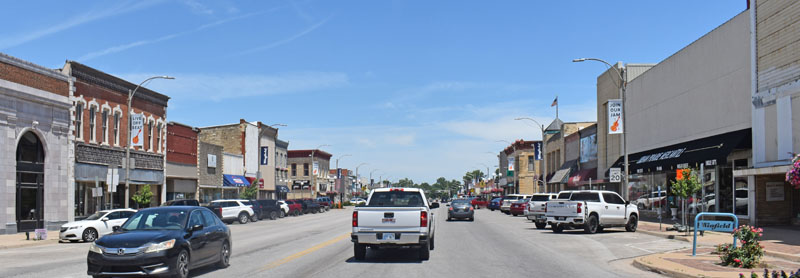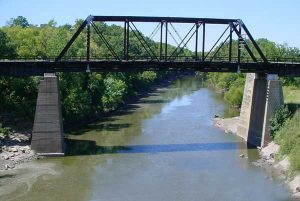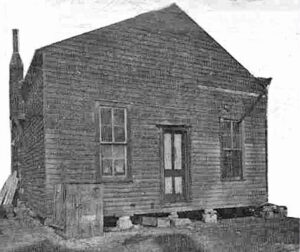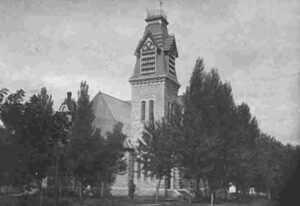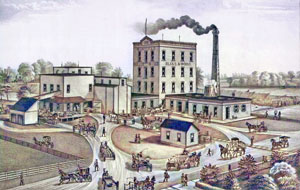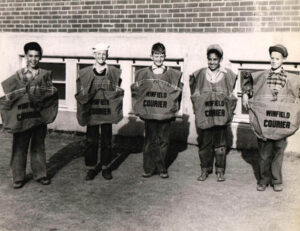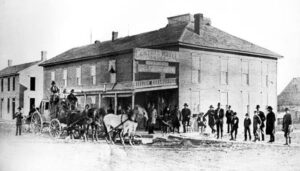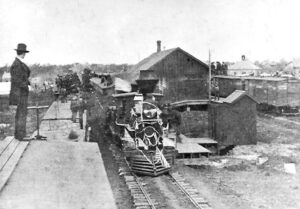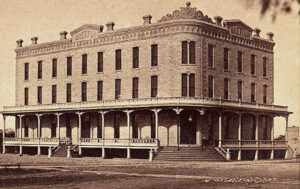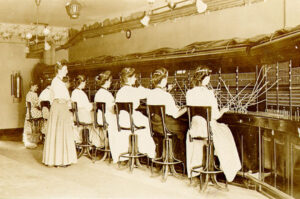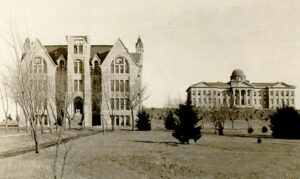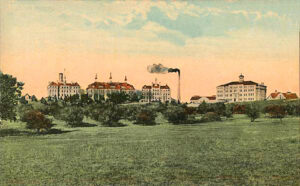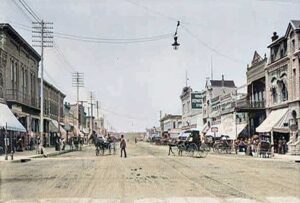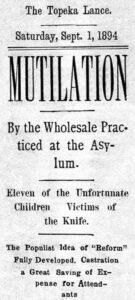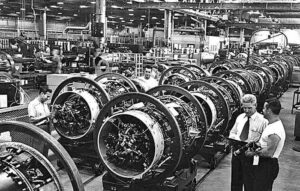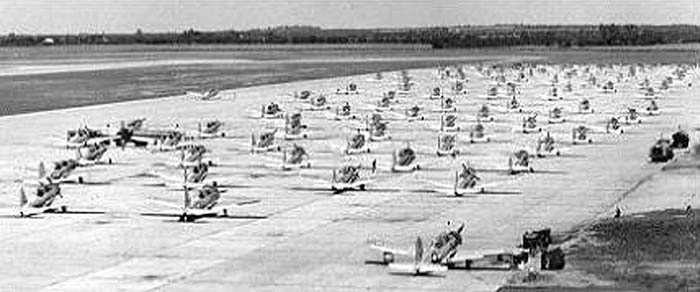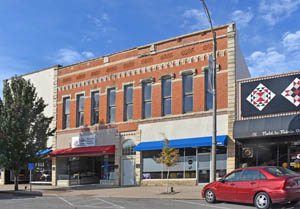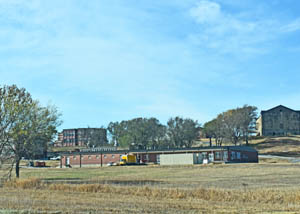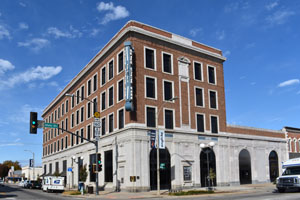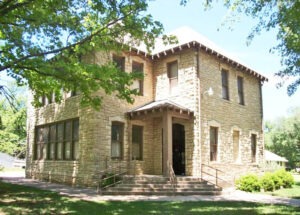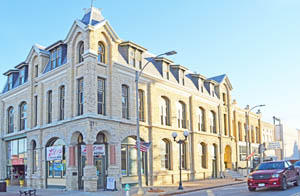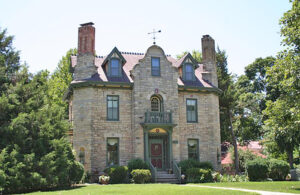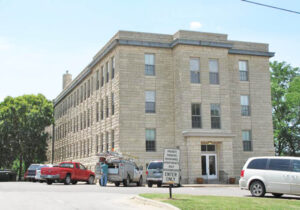Winfield, Kansas, is the county seat of Cowley County. It is located on the Walnut River at its confluence with Timber Creek in the south-central part of the state. As of the 2020 census, the population of the city was 11,777.
In June 1869, when C.M. Wood had his stockade on the west bank of the river opposite where the townsite would later be situated, he thought his wife should name it. After some deliberation, the name Legonda was selected, and the settlement was briefly known by that name. W.W. Andrews, who took a claim in 1869 and returned to Leavenworth, Kansas, for his family, used as a strong argument that the settlement should be named in honor of Winfield Scott, a Baptist minister of Leavenworth, who raised $500 for the support of a church, and Reverend Scott should come and be its pastor. It was decided that the settlers would vote upon the name, an election was called, a formal ballot was taken, and a dance followed. Legonda lost the day when a count of the ballots resulted in favor of Winfield.
E.C. Manning took the first claim on the Winfield town site on June 11, 1869. Afterward, W.W. Andrews, C.M. Wood, and A.A. Jackson took adjoining claims.
On January 13, 1870, the Winfield Town Company was organized with Colonel E.C. Manning, President; W.W. Andrews, Vice-President; C.M. Wood, Treasurer; W.G. Graham, Secretary. Forty acres of the land belonging to E.C. Manning was laid out as the center of the new town, and Main Street, 120 feet wide, was laid out north and south of this land. A log house was put up on the main street by the settlers and given to Manning in exchange for his land taken by them. Colonel E.C. Manning figured prominently in the town’s early growth and became the first postmaster when the post office was established on May 3, 1870. The post office was kept in the log cabin, where he stored a stock of goods.
Settlement on the townsite was slow, and when on August 15, A.D. Millington and J.C. Fuller of the Winfield Bank arrived and purchased Jackson’s claim. At that time, the only buildings were the log store of E.C. Manning, the log blacksmith shop of Max Shoeb, the drug store of W.Q. Mansfield, and the hardware store of Frank Hunt. Millington and Fuller immediately took active steps to advance the town.
Through his efforts, the legislature’s organization of the county with Arkansas City as the county seat was thwarted, and Winfield became the county seat later in the year. It took until July 1870 to get the proper titles to the town site so that lots could be deeded. After that, the town grew very rapidly for a few months, and hotels and all lines of business, including a bank, were established before the year was out.
Miss Annie Marks taught the first school, which was paid for by subscription.
The Methodist Church was organized in the spring of 1870 by B. C. Swartz, who became its pastor. When organized, the society had a membership of eleven. Meetings were held in a little frame church on Ninth Avenue for a long time. A church was erected in 1875 for $12,000. It was of stone and, when first erected, had a spire 100 feet high of the same material. This, however, soon yielded to the force of the Kansas winds. By the early 1880s, the church membership was 300. A neat parsonage stood on the church lot. A Sabbath school, organized at. At that time, the church had an average attendance of 200 and was in charge of Mr. S.H. Jennings.
A post office was established at Winfield on May 3, 1870, with E. C. Manning as Postmaster. The office was in an old log store, where the opera house would later be built. Manning held his position briefly, and A. W. Tousey followed suit the same year.
The first newspaper was the Censor, established in August 1870 by A.J. Patrick. It is said to have been printed on the old Franklin style of press called the Meeker, first brought to the state by the missionaries and used at the Shawnee Mission in Johnson County. This press was later moved to Lawrence, Kansas, where it figured in antebellum troubles; later, it was used at Emporia and Cottonwood Falls by Colonel Samuel Wood, who sold it to the Winfield parties.
J.C. Fuller started the Winfield Bank, the first banking house established in the county. It opened its doors in the fall of 1870.
The Baptist Church was organized on November 27, 1870, by Reverend Winfield Scott, in honor of whom the city is named. Reverend E.P. Hickok supplied the society for about a year, followed by Reverend N. L. Rigby. The church membership rose from eleven in 1871 to 180 in 1882. One of the society’s first acts was erecting a stone church, which was used from its completion in 1872 to 1878. Soon after, services were held in the opera house, where they continued until the completion of the new church in 1882. This building was said to be the finest in southern Kansas. Built of fine limestone found about two miles from the city, it cost $14,000 and seated 700. It was fitted throughout with St. Louis opera chairs. A Sabbath school was organized in April 1878, with J. McDermott Superintendent and an average attendance of seventy. In 1882, it had over 200 and was in charge of E. T. Trimble.
In January 1871, the United States Deputy Surveyors, O.F. Short and Angell, surveyed Cowley County. This survey furnished a new excitement for the settlers, for the survey lines did not conform with the claim lines. There was a crowd of settlers following each surveying party, with teams and lumber, and whenever the survey showed a good bottom claim to have no shanty or other improvements on it, the first one who got to it with lumber or logs took the claim. Some people found their improvements surveyed on to the claims of older settlers and thereby lost their claims. All this resulted in many contests at the land office, and it was remarkable that very little violence was resorted to.
The same month, E.C. Manning, J.C. Fuller, and D.A. Millington formed another company called the Winfield Town Association and joined the southeast quarter of Manning’s claim with the west half of Fuller’s claim as the association’s property. This added to the town company’s 40 acres, made a town site of 160 acres in square form, and D. A. Millington, who was then the only surveyor and engineer settled in the county, surveyed this townsite off into blocks and lots, streets, and alleys. Though the three people named above had control of most of the stock of the town company, there were several other stockholders in the company. Hence, the addition of the townsite, which the three men wholly controlled, created a different ownership and the need for the new corporation, the Town Association.
In spring, new buildings continued to be built on the townsite, stores, and shops were filled, and dwellings were occupied. It took a long time, or until July 10, for the notes, plats, and records of the survey to be made out and recorded in the offices at Washington and Lawrence and get ready to open the land office at Augusta. During this time, the occupants of the town site began to get restless and demanded that the companies give them more lots for free. Some urged that the companies had no more right to the town site than anyone else and that all unimproved lots legally belonged to the owners of the improved lots, to be divided pro rata. These disaffected parties became so numerous as to embrace a significant proportion of the 72 owners of buildings on the town site. They procured the services of a great land lawyer of Columbus named Sanford, made an assessment, and collected money to carry out their measures, held meetings in which excited speeches were made against the two corporations and were prepared, at a moment’s notice, when the land office was open, to rush in and enter the town site, through the Probate Judge, who should distribute lots to the inhabitants, according to their theory. Thus commenced the famous Winfield town site controversy.
The Winfield Messenger was started on January 13, 1872, as the direct successor of the Censor and was printed from the same material. On July 4, 1872, Yale Brothers purchased the office of W. Kerns and ran the paper until December 5, when it died a natural death.
Winfield City Mill was built in 1872 by C.A. Bliss & Co. The building was 40 x 30 feet and had two and one-half stories. It started with three runs of buhrstones, but later, two buhrs and three rolls were added. That year, a $10,000 school building was erected.
Read’s Bank was started in 1872 by M.L. Read. As a private bank, it had no statement of resources but was known to have invested a capital of $75,000 and a surplus of $25,000. The bank building on Main Street, near Ninth Avenue, was erected in 1871-72 for $7,500. This was the first brick building in the county, and the brick used in it was the first manufactured, with brick-makers being imported for that purpose. Various improvements in vaults and fixtures increased the valuation of the building to a total of $8,000.
The Cowley County Telegram was first issued at Tisdale on September 12, 1872, under the management of W.M. Allison. Five issues were circulated at Tisdale before the office was removed to Winfield. On January 1, 1873, Arthur H. Hane bought an interest in the paper but became dissatisfied with the business and sold it out on March 20 to A.B. Steinberger. He, in turn, wearied of the uphill work of frontier newspaper life and retired on July 3. Allison ran the paper alone until 1873, when Bert Crapster bought an interest and established a daily edition. Two years later, Crapster sold out, and Charles C. Black purchased the entire business after a few weeks of partnerships with Allison. Extensive improvements were at once made; a fine stone building was erected, and one of the best offices in the state was procured. Winfield was, however, too small to support a good daily paper, and on November 1, 1881, the Telegram vanished from the scene; the material was sold to A.B. Steinberger, who used it on the daily and weekly Courant. On July 10, 1882, the Telegram was revived on the ruins of the defunct Courant by Sam E. Davis and George Rembaugh. It is now a nicely printed Democratic weekly of forty-eight columns.
The Christian Church was organized on the fourth Sunday of September 1872, with a membership of 31. P.F. Whittaker and Henry Hawkins were elected Elders. On the fourth Sunday of October, Reverend Erastus Lathrop began revival meetings, which lasted ten days and added 15 members to the society. The first pastor was Reverend Mr. Womack, who came in 1872. The early services were held in the Baptist Church, but in 1873, the society built a small church for $1,000. A new church, measuring 36 x 54 feet and costing $2,500, was begun in December 1882. At that time, the church enrollment was 125. A flourishing Sunday school, organized in 1872, was attached to the church, had a membership of 75, and was in charge of T.R. Bryan.
The Winfield Courier appeared on January 1, 1873, hearing the names of R. S. Waddell & Co. as publishers. Waddell was manager, and J. C. Little, local editor. On March 27 of the same year, the office changed hands: James Kelly, now of the Sumner County Wellingtonian, becoming editor, and Vinnie B. Beckett, local. This arrangement lasted until July 1, 1875, when Wirt W. Walton took the local page. On November 11 of the same year, Kelly sold out to E. C. Manning. On August 16, 1877, the office was sold to D. A. Millington and A. B. Lemon, who took the editorial and local pages, respectively. January 1879 saw the last change, which placed the paper in the hands of the Courier Company and, while retaining Mr. Millington, gave the local page to Edward P. Greer, who still holds it. The Courier office was one of the most complete in the southern part of the State, having a large variety of types and, besides the usual supply of job presses, a large power press for newspaper and poster work. The paper is a nine-column folio of excellent makeup and is a worthy exponent of the county and city.
The Presbyterian Church was organized on January 19, 1873, by Reverend A.R. Naylor of the Home Missionary Society. It had no regular pastor but was assigned to Mr. Naylor, who had come to the state hoping to regain his health. However, by May 23, he found the work too arduous, and with Mr. Naylor retiring, the church was without a pastor until July, when Reverend J.E. Platter arrived. At that time, the society consisted of seven charter members, but 22 others who had been church members in other places but had never formally lost membership were placed upon the rolls. John P. McMullen and William Greenlee were elected Ruling Elders, and the church was put in working order. The organization’s work was conducted, and the first separate services were held in the Hudson building, which was used as a carriage paint shop. This was fitted up with chairs and rejected school benches. From this place, the society moved to the courthouse, where services were held until the church building was ready for occupancy. This was on September 23, 1877. The church had been in the building for some time, the basement being first finished and used not only for devotional purposes but also by a part of the city school. As completed, the structure is well worthy of any city. It is made of brick, has a stone basement, has a seating capacity of 400, and costs $8,000. A Sabbath school was established in September 1877, under the supervision of the pastor, with an attendance of 100. In 1882, it was in charge of Mr. T. B. Myers and had an average attendance of 200.
Winfield was incorporated as a third-class city on February 22, 1873. On March 7, the first city election took place, and the results were as follows: W. H. H. Maris, Mayor; J. W. Curns, Clerk; A. A. Jackson, Police Judge; M. L. Robinson, Treasurer; C. W. Richmond, Marshal; and J. M. Alexander, Attorney. The Council consisted of O. F. Boyle, C. A. Bliss, J. D. Cochran, H. S. Silver, and S. C. Smith.
Colonel John M. Alexander started the Plow and Anvil newspaper on November 19, 1874. On April 22, 1875, it was sold to Amos Walton and C.M. McIntire, who, in March 1876, changed its name to the Cowley County Democrat. On August 16 of the same year, the material was sold to W.M. Allison, who removed it from the county.
In 1878, a long wooden building in the northwest corner of the First Ward school block was built to accommodate the primary school department and ease the overflowing main building. Before this, the basement of the Presbyterian Church and other buildings that could be rented had been in use for two years. After the city’s division into wards, the old school building was entirely remodeled, and the north wing of the First Ward school was formed. This building cost $6,000 and is one of the most luxurious in the state. It was made of limestone found near the city and has four rooms. The teachers in this ward were E. T. Trimble, Principal, Mrs. E. T. Trimble, Miss S. J. Clute, Miss Mattle Gibson, Miss Alice E. Dickie, Miss T. E. Goldsmith, and Miss Rose Rounds. The primary department is taught by Mrs. W. B. Caton and Miss Mary Bryant in the long wooden building.
The only machine shop in the city was Clark & Abbott. It was started in 1878 by S. Clark. It was fitted with a lathe, planer drill, and all tools necessary for ordinary manufacturing or repair work. All the shafting for the roller was made here. The shop was valued at $3,000.
The post office was moved to the rear of the Telegram building in 1878 and served a year later as the starting point of the fire that swept the corner of the block. It then moved to T.K. Johnson’s and then back to the first position, where it was moved again, occupying several places on Ninth Avenue.
In January 1878, J.C. McMullen, engaged in similar business in Arkansas City since 1871, came to Winfield and started the Citizens’ Bank. On April 1, 1879, the two banks consolidated and formed the Winfield Bank. In 1882, the institution had a cash capital of $50,000 and a surplus of $25,000. Besides this accumulation, it had paid every year since its organization a semi-annual dividend of ten% – a record probably without parallel in banking records. This remarkable success is due to two causes – careful management and immense tributary territory. The building occupied and owned by the bank was erected in the summer of 1879 for $8,000. It had two stories and a basement; the latter was occupied by the Courier office and the second floor by various offices.
The African American Episcopal Church was organized in 1879 by Reverend A. H. Daily, who, although located in Wichita, became its pastor. A church was erected in 1880 at a cost of about $600. The church membership in 1882 was 25. A Sabbath school was held at private houses before the church’s organization. It is now in charge of L. C. Scott, with an average attendance of 30.
Winfield became a city of the second class in 1879. It was then divided into two wards, the First covering all east of Main Street and the Second covering all West of that line. The population was then more than 2,000.
The first telegraph arrived in Winfield on September 25, 1879. Five days later, the first train reached Winfield on September 30, 1879. On that day, 4,000 people arrived on two trains from Wichita. A parade was held from the depot to the fairgrounds. Attendees cheered their favorite baseball team as Wichita played Winfield. Winfield won the game, and afterward, a ball was held at Manning’s Opera House. Eventually, a total of five railroads passed through Winfield.
The school building in the Second Ward was built in 1880 for $6,000. It was the counterpart of the First Ward School and had four rooms. Miss M.E. Hamill, Miss E. McCrippen, Miss Ella S. Kelly, and Miss A. Klingman taught there. The school has 250 students, while the enrollment of both schools is 893.
Grace Episcopal Church was organized in April 1880, with a membership of 20 and Reverend S.M. Fry as rector. The church’s services were held in the District Courtroom. A Sabbath school was organized in October 1880 under the supervision of L.H. Owen, and in 1882, it had an average attendance of 50.
The Horning Elevator was built by Fowler & Simpson in the fall of 1880 on the track of the Atchison, Topeka & Santa Fe Railroad for $4,500. J.H. Horning purchased it in the fall of 1882. It had a wheat cleaner and corn sheller and could clean and handle four cars of wheat and one of corn daily. An engine of 20 horsepower furnished power.
The Winfield Carriage Works were started in December 1880 by W.F. Doorley, who operated them until July 1881, when the firm was changed to Albro & Doorley. No heavy wagons were sold; many carriages, buggies, and spring wagons were made. The first two years’ production amounted to 1,007, 700 of which were built in 1882. This was said to be the largest carriage factory in the state; it had a capital of $13,000 and employed 25 men.
In 1880, B.F. Wood became a partner in the Winfield City Mill, and in January 1881, a 100-horsepower engine was installed to aid the four turbine water wheels before they were used.
The Brettun Hotel was built in 1880-81 by S. L. Brettun and was opened on August 11, 1881, by Harter & Black. The building was of sawed magnesian limestone, with trimmings of the same material; it was three stories in height, with an English basement equivalent to another story, and covered a ground space of 55 x 100 feet. The house was heated throughout by steam and lighted by gas of its own manufacture. It was valued at $35,000 and was said to be the finest hotel in Southern Kansas. On December 1, 1882, Black retired from the hotel, and his senior partner began to operate it.
The Cowley County Courant was printed on the Telegram material. Both daily and weekly editions were printed, and the hopes of its publisher, A.B. Stineberger, ran high. However, after preaching Republicanism from November 1, 1881, to July 1882, it yielded to the inevitable and “passed over to the great majority” of frontier dailies.
The Building and Loan Association was organized on January 1, 1882, with H.G. Fuller, President; A.H. Hendricks, Vice President; J.E. Platter, Treasurer; and J.F. McMullen, Secretary. It prospered finely during its first year of business and had $1,500 loaned on its first mortgages.
On March 27, 1882, the Telephone Exchange connected 24 of Winfield’s principal points. This work was done by P.W. Bossart of Kansas City, Superintendent of the Bell Telephone Company.
The Johnson Elevator was begun in July 1882 and finished the same year by Allen Johnson. It stood on the Kansas City, Lawrence & Southern Kansas Railroad track, had a storage capacity of 12,000 bushels and could load ten cars daily. An engine of ten horsepower furnished power.
On August 13, 1882, the Winfield City Mill burned to the ground, with only the water wheels and part of the engine escaping. At that time, the property was valued at $30,000. With undaunted courage, the sufferers of this fire went to the task of rebuilding, to make not only a finer mill than the old City Mills but also the finest in the state. They succeeded, and the new roller mill was completed in January 1883. It was of sawed magnesian limestone, five stories in height, and covered a ground space of 40 x 60 feet. The motive power was the same as that of the old mill. The other machinery consisted of 34 pairs of rolls, ten purifiers, 26 bolting and four centrifugal reels, four flour packers, one bran packer, and a bran duster. The mill was rated at 350 barrels of flour per day. Its cost was $50,000. Attached to the mill was an elevator with a capacity of 30,000 bushels, valued with its machinery at $4,000. A side track of the Atchison, Topeka & Santa Fe Railroad ran to the mill, and shipments were made.
The Winfield Creamery was started in January 1883, and the buildings were put up in the preceding fall. It ran 15 wagon routes for collecting cream at full capacity and turned out a ton of butter daily. The creamery proper was 40 x 36 feet, and the ice house adjoining was a trifle larger. An eight-horsepower engine furnished power.
In June 1885, the Board of Trustees of the South West Kansas Conference of the Methodist Episcopal Church filed incorporation documents for “The South West Kansas Conference College” with the Kansas Secretary of State. The college location would be at “College Hill” in Winfield. In March 1886, the erection of the college building began. Designed by Willis A. Ritchie, a 21-year-old local architect, the imposing four-story structure was completed at about $60,000, making it one of Winfield’s most expensive structures at the time. The first day of classes for the college was on September 8, 1886, with an enrollment of 43.
In 1887-1888, the Kansas State Asylum for Idiotic and Imbecile Youth was moved from Lawrence, Kansas, to a hill overlooking Winfield. The new location, further away from the more public University of Kansas central campus, allowed the Asylum to become more self-sufficient, using the young students as an indentured workforce, raising vegetables, meat, and grain, having its own water, and even putting out its fires instead of relying on the public fire departments. Its objective was to train and educate them to render them more comfortable, happy, and better fitted to care for and support themselves.
The course of study was adapted to the mental conditions of the students. Girls were taught sewing and simple domestic work, and the boys were instructed in farm work or such manual labor as they were competent to perform. All are taught to take care of their bodies, and many children who would otherwise go through life practically helpless left the school able to care for themselves and to engage in some useful employment.
On July 1, 1893, Dr. F. Hoyt Pilcher was named the superintendent of the Asylum after an increase in the number of students. This was when the eugenics movement began to have a more significant influence on the hospital than the Progressive movement. In this state home, Pilcher de-sexed his patients, no longer focusing on simply keeping the “feeble-minded” in the institution but sterilizing them so that, if they left the institution, they would not enter society sexually. The number of students at the Institute grew exponentially. In 1900, it housed 173 people; in 1910, it was 419. In 1909, the name changed to the State Home for the Feeble-Minded after many of the people with epilepsy in the institution had been sent to the newly founded Parsons Institute, which attempted to use newly discovered medical treatments for epilepsy. By 1916, the hospital housed 589 patients. Later, called the Winfield State Hospital and Training Center, the facility served for 117 years and was a dominant local employer.
On June 3, 1889, Southwestern College graduated its first class—three students. The school became a leading local institution and employer, drawing students from throughout the central United States and bringing an extra level of intellectual and cultural development and diversity to the community.
In 1890, the population was 5,184; in 1900, it was 5,554.
On August 13, 1903, 30-year-old Gilbert Twigg, armed with a 12-gauge double-barrelled shotgun, opened fire at a concert, killing six people and wounding at least 25 before killing himself. Three others died in hospitals afterward.
In June 1893, the cornerstone for St. John’s College was laid. Under the control of the English Evangelical Lutheran church, it was established due, in a great measure, to the generosity of John P. Baden, a wealthy citizen of Winfield and a prominent member of the Lutheran church. Early in the 1890s, he gave $50,000 toward founding the institution; a site was selected in the eastern part of the city, and plans were made for a two-story stone building measuring 60 by 100 feet, with a basement and attic. The following September, the school was opened with a faculty of five members. The college building was not entirely completed, and temporary quarters for classrooms were secured elsewhere until March 1, 1894, when the building was finished and formally dedicated. The college course embraced three departments — classical, literary, and scientific — and no debt had been incurred. Mr. Baden died on March 3, 1900, but the school he founded was an enduring monument to his generosity.
The Winfield-Arkansas City area became an industrial community in the 20th century, manufacturing consumer goods and, eventually, aircraft and aircraft parts.
In 1910, Winfield was on the Atchison, Topeka & Santa Fe, the St. Louis and San Francisco, and the Missouri Pacific Railroads. At that time, it was an incorporated city with an electric street railway, sewer system, fire department, waterworks, broad, well-paved, and shaded streets, electric lights, three parks, two daily newspapers — the Courier and the Free Press, flour mills, grain elevators, machine shops, carriage, and wagon works, marble works, ice and cold storage plant, department stores, and all other lines of retail establishments, telegraph and express offices, and an international money order post office with ten rural routes.
The town was amid a fine farming district and shipped great quantities of livestock, grain, produce, and dairy products. Good-quality magnesian limestone was quarried in the vicinity and shipped from this point. A great many retired farmers live in the town, as do a large number of traveling salesmen. The population in 1910 was 6,700.
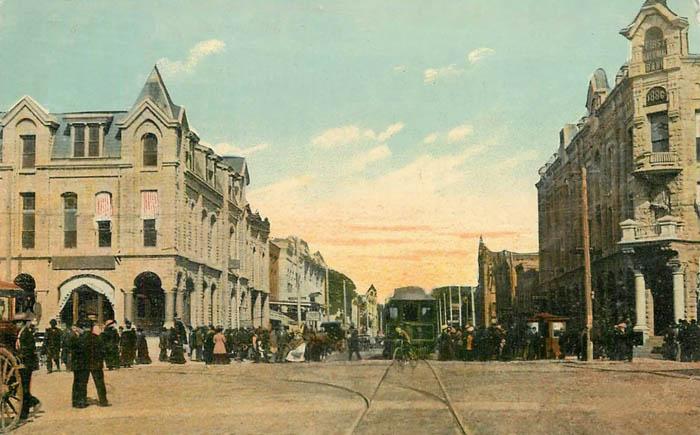
Winfield, Kansas, 1910.
The Second Regiment of the Kansas National Guard’s armory was located here. In addition to the excellent public schools, there was St. Martin’s Lutheran School and a Congregational school. The Winfield College of Music and the Central Sanitarium were among the privately owned institutions. A live businessmen’s association looked after the town’s general interests.
In 1916, Gott Manufacturing was established in Winfield to produce metal water coolers. Over the next 70 years, the enterprise became a major supplier of insulated water jugs and urns.
By the 1920s, the emphasis of the State Home for the Feeble-Minded was placed on agricultural productivity, as both the male and female clients were put to work throughout the institution so that it could become its own system. The institution no longer trained the students to live in society but in their self-created world.
Pi Gamma Mu International Honor Society in Social Sciences was founded at Southwestern College in Winfield in 1924. The international headquarters is now housed at a repurposed Carnegie Library building on Millington Street in downtown Winfield. Pi Gamma Mu is the oldest and preeminent interdisciplinary social science honor society. Its mission is to encourage and promote excellence in the Social Sciences and to uphold and nurture scholarship, leadership, and service.
In 1930, the State Home for the Feeble-Minded was renamed the State Training School, at which time the emphasis was on discipline, cost-cutting, and farm productivity. At that time, further sterilizations occurred. The population at Winfield peaked during WWII when it reached 1,245 clients in 1942.
In World War II, Winfield and neighboring Arkansas City became home to Strother Field, a military pilot training base. This base remained in operation until the end of the war, bringing several thousand military personnel into the area. After the war, in the early 1950s, the field became the shared municipal airport and industrial park for Winfield and neighboring Arkansas City.
After the war, Kansas hospitals for people with disabilities were assessed, and several problems were found at Winfield State Training School. Although there were no recorded accounts of physical abuse, handcuffs, leg irons, and whips were found in the hospital.
The aircraft manufacturing industry in nearby Wichita — one of the world’s principal aircraft manufacturing centers — employed many Winfield residents, directly and indirectly. That opportunity grew substantially in the last half of the century, as General Electric’s G.E. Aviation division, in the late 1940s, began producing engines for Wichita aircraft, and eventually, in the 1960s, one of Wichita’s principal manufacturers, Cessna Aircraft Company built a factory at Winfield’s Strother Field.
In 1951, G.E. Aviation, an aircraft-engine division of General Electric at Strother Field, began producing General Electric J47 jet engines for U.S. military aircraft — notably the Boeing B-47 Stratojet intercontinental bomber, built primarily in Wichita, and also built by Douglas Aircraft at Tulsa, Oklahoma. Approximately 3,000 of those engines were produced at Strother by 1955.
A Crayola plant near Winfield was established in 1952. At the time, it was the only Crayola plant that made paints. The plant provided a large part of the jobs in the county. Tours were conducted until 1992, and five years later, in 1997, the plant shut down and moved to Pennsylvania. Many original crayons and memorabilia can still be seen at the Winfield Museum.
In 1953, the airport reverted to shared control of Winfield and Arkansas City and became a major industrial center for both communities, which it remains to the present.
With the end of the Korean War, the G.E. factory switched to overhauling jet engine parts and accessories. In 1962, G.E. began overhauling and repairing entire military jet engines and related parts and accessories — ultimately processing over 6,000 jet engines between 1962 and 1975.
With the advent of business jets in the mid-1960s, led by Wichita’s Learjet — the Strother Field G.E. facility switched to servicing G.E.’s business jet engines, ultimately processing over 6,000 by 1975, as the factory grew to 125,000 square feet. During those years, several hundred business jets worldwide flew into Strother Field to be serviced directly at the G.E. facility. Subsequently, G.E.’s Strother facility overhauled J33 military and General Electric CF6 engines for “jumbo” jetliners.
In 1967, Cessna Aircraft Company, the world’s highest-volume aircraft producer (mostly light aircraft), addressed booming demand for its smallest, most popular aircraft by opening a Cessna factory at Strother Field. Initially, the factory produced the Cessna 150, the world’s most popular two-seat light aircraft.
In 1975, Cessna also began to move the assembly of the world’s most popular light aircraft, the Cessna 172, from its Wichita factory to Strother Field.
Strother Field produced several thousand aircraft models and employed several hundred to a few thousand workers until the 1980s. The recession and other factors crashed the market for light aircraft. Following layoffs of 700 workers at Strother Field, Cessna eventually shut down the Strother Field factory in the early 1980s.
In 1985, G.E. acquired much of the abandoned Cessna facility for its engine overhaul enterprise.
In 1986, Gott Manufacturing was acquired by Rubbermaid, a globally dominant manufacturer of rubber storage containers. It then converted to producing Rubbermaid-branded products, including insulated water coolers, ice chests, outdoor living products, and outdoor storage products. Subsequent expansion of its facilities has continued to the present day.
St. John’s College closed in 1986. Two years later, the City of Winfield purchased the campus and renamed it Baden Square. Afterward, efforts were made to utilize each of the buildings.
In February 1987, 14 employees were fired, and 13 were suspended from the Winfield State Hospital and Training Center after claims of client abuse in the men’s wards. In 1991, after a long history of turmoil at Winfield, the governmental process of closing the hospital’s doors began. It was part of a movement fostered by the idea that the developmentally disabled had civil rights that should be protected.
Finally, in March 1998, after much debate, Winfield State Hospital and Training Center closed its doors. At that time, it was the oldest and largest of the three Kansas state hospitals for developmentally disabled people. During its many years, it housed up to 1,492 patients at its maximum in 1952. The site then became the Winfield Correctional Facility. Today, it is a minimum-security facility for adult male residents with a capacity of 554. It is a re-entry site designed to provide a smooth transition from an institutional setting to the community for residents expected to be paroled soon.
In the 21st century, Winfield remained an industrial and institutional town. Except for Cessna, most of the area’s major employers continued into the early 21st century. The Strother Field municipal airport remains the site of the area’s principal industrial park, employing thousands.
In 2010, Phase II of the Keystone-Cushing Pipeline was constructed west of Winfield, north to south through Cowley County, with much controversy over tax exemption and environmental concerns should a leak occur.
Winfield’s population peaked in 2010 at 12,301.
In 2011-2012, Rubbermaid announced it was moving 200 jobs from a Texas factory to Winfield, increasing its Winfield capacity to add manufacturing of Rubbermaid’s trash cans and home-organization products. Further, Rubbermaid would invest $26.6 million to expand its operations, beginning construction of a 500,000-square-foot distribution center next to its factory. In early 2017, the company employed 1,054 people.
G.E. Aviation, which began operations in Winfield in 1947, has continued and, in April 2017, employed 750 people in the area.
Creekstone Farms’ beef processing plant in neighboring Arkansas City, Kansas, employed over 600 people in early 2017. At that time, hospitals and nursing-care facilities in Winfield and Arkansas City combined employed over 600 workers, with about half at William Newton Memorial Hospital in Winfield. The Winfield Correctional Facility employed another 200.
The community is served by Winfield USD 465 public school district.
Southwestern College is located in Winfield. It is a four-year private higher educational institution affiliated with the United Methodist Church.
According to the United States Census Bureau, the city has a total area of 12.93 square miles, of which 11.56 square miles is land and 1.37 square miles is water.
Winfield is well known for hosting the Walnut Valley Festival, one of the nation’s oldest and largest bluegrass and acoustic music festivals, on the third weekend of every September. Crowds have exceeded 15,000, arriving from across the nation — with hundreds of bluegrass and acoustic music enthusiasts camping, socializing, and “jamming” at the site for weeks before the festival begins. The event also often features folk music, Celtic music performances, and related cultural activities and exhibits.
Several sites in Winfield are listed on the National Register of Historic Places.
The Bryant School, at 1011 Mansfield Street, was constructed in 1880 for Winfield’s second ward. It is the only extant school building that illustrates the town’s earliest public education history. As the town’s population grew, the school building was expanded to include additional classroom space, first in 1916 and then in about 1922 when a separate elementary building was built on the north side of the parcel. The main school building was again updated in 1938 to accommodate better circulation and the building’s first indoor restrooms. The school continued to serve the children of western Winfield until 1964. By the end of the 1960s, this was the home of the Cowley County Historical Society Museum, which continues to own and operate it today. The school complex is significant for its association with Winfield’s public education history and its local architectural significance as an example of the City Graded School. The two-story Vernacular-style stone building has a basement and a cross-hip roof. It was listed on the National Register of Historic Places in October 2017.
The W.H. Coffin House at 421 E. 11th Avenue exemplifies Queen Anne-style architecture. The two-and-a-half-story, wood-frame residence with a wrap-around porch was built in 1892. Interior details include intricate oak and maple wood moldings around doors and windows, pocket doors separating the parlors and other rooms on the first level, a prominent front staircase, an oak mantel and fireplace in the front parlor, built-in cabinets in the dining room, and a continuation of detailed woodwork on the upper level. These elements are typical of the late 19th-century residential architecture styles and display great craftsmanship. It was listed on the National Register of Historic Places in August 2003.
The Cowley County National Bank Building at 822 Main Street was completed in 1886 and was first occupied as the Farmers’ Bank. From 1891 until 1922, it was operated at the Cowley County National Bank. The two-and-a-half-story stone building, designed in the Second Empire style, was built in 1886. It was listed on the National Register of Historic Places in August 1983.
The East Badger Creek Culvert, also called the Thomson Bridge, was built from 1905 to 1906 by bridge builder Jerry Hammon. It crosses East Badger Creek. The Stone Arch bridge is approximately 29 feet long and 20 feet wide. It is supported by a single wide stone arch that rises from springer blocks reinforced with concrete pads set within East Badger Creek. The culvert’s deck is gravel on concrete. The south edge has a concrete rail approximately 24 inches tall and 12 inches wide. It is located on 182nd Road, 0.3 miles east of 131st Road, in the Winfield vicinity. It was listed on the National Register of Historic Places in December 2015.
The Grace Methodist Episcopal Church, 320 College Street, was built in the Collegiate Gothic style in 1917. The three-story brick building’s windows extensively use opalescent glass in multiple layers. Three of the four walls in the sanctuary are designed around large stained-glass windows. There is a total of 1030 square feet of stained glass in the sanctuary. A two-story brick education wing was added in 1959. It was listed on the National Register of Historic Places in November 2005.
The W.P. Hackney House at 417 E. 10th Avenue was built in 1886 by prominent Kansas lawyer and politician William Patrick Hackney. The Hackney house was described in the Winfield Courier of December 30, 1886, as being “first among the most commodious of the city, modern in exterior and interior, and furnished with a richness and subdued splendor.” A 1901 account described it as “the handsomest and most substantial residence in the city.” The three-story Vernacular-style home with a full basement was built of stone and has a Garage/Carriage House. The house was remodeled in the 1930s, but its appearance remained unchanged. It was listed on the National Register of Historic Places in March 1973.
The Magnolia Ranch house in rural Cowley County near Winfield is a two-and-one-half-story early Renaissance-style structure with a full basement. The rectangular stone dwelling, designed in the Italian Renaissance style, was built in 1883. The coarse facing of the stone gives a massive appearance to the building. Two large observation towers in the center of the roof admit light into the attic. Several chimneys with stone caps protrude from the roof. The ranch complex includes three small stone buildings west of the residence, used as an ice house, a smokehouse, and an outhouse. Northeast of the house are two large buildings of rubble stone construction; the shorter one is a barn, and the longer one is used as stables. A large frame porch, which once wrapped around the east and portions of the north and south facades, has been removed. It is located at 13816 234th Road, about 11 miles southeast of Winfield, Kansas. It was listed on the National Register of Historic Places in March 1973.
The Pettit Cleaners Building, at 114 E 8th Avenue, is a commercial building designed in the Streamlined/Art Moderne style. The two-story rectangular building was constructed in 1880. It was listed on the National Register of Historic Places in January 2005.
St. John’s Lutheran College-Baden Hall – Baden Hall, once part of St. John’s Lutheran College, was built in 1893-1894. Founded by John P. Baden, one of Winfield’s prominent 19th-century businessmen, St. John’s was distinguished as one of two private, denominational colleges in the city. Baden Hall was constructed as the original facility at St. John’s – the only one associated directly with Baden himself – and, for 20 years, it was the sole building on the campus. The building’s function evolved from the primary classroom and dormitory space on campus to administrative offices. The college ceased operations in 1986, and since then, most of the buildings have been adaptively reused by the City of Winfield for various purposes. Today, the building serves as an apartment building. It was listed on the National Register of Historic Places in January 2011 for its significance as a prominent local educational facility. The Romanesque-style building is located at 619 College Street in Winfield, Kansas.
St. John’s Lutheran College – Mundinger Hall – Once part of St. John’s Lutheran College, Mundinger served as a girls’ dormitory. It was constructed in two phases between 1950 and 1953. It was listed on the National Register of Historic Places in January 2002 for its significance with its association with education and architecture. After the school closed in 1986, the three-story stone Late Gothic Revival building was renovated into apartments. It is located at 1315 E 6th Avenue in Winfield, Kansas. It was listed on the National Register of Historic Places in January 2005.
St. John’s College – West Dormitory – This rectangular four-story stone school was designed in the Late 19th and 20th Century Classical Revival with a flat roof and parapet. One of the early St. John’s College buildings, this dormitory called Rehwinkle Hall is the second oldest surviving on campus and one of three buildings most closely associated with the college’s early history. Serving as Rehwinkel Hall Apartments today. It was listed on the National Register of Historic Places in December 1991. It is located at 1415 E. 6th Street in Winfield, Kansas.
The Silver Creek Masonry Arch Bridge was built in 1907 by Walter Sharp. The native stone double masonry arch bridge is 140 feet long and 18 feet wide. The double arches are unequal, with the southern arch almost round and the northern arch almost oval. The iron pipe railing dates from the construction of 1908 to 1909. It was listed on the National Register of Historic Places in January 1987. It is located on 192nd Road, about five miles East of Winfield on US-160, three miles South 151st Road, and two miles East 192nd Road.
Winfield, Kansas, is about 40 miles southeast of Wichita. It is located 17 miles north of the Kansas-Oklahoma state border at the junction of U.S. Routes 77 and 160. Arkansas City is 13 miles south of Winfield along U.S. Route 77, and Strother Field, a general aviation airport, is approximately five miles south.
©Kathy Alexander/Legends of Kansas, updated July 2024.
Also See:
Sources:
Blackmar, Frank W.; Kansas: A Cyclopedia of State History, Vol I; Standard Publishing Company, Chicago, IL 1912.
Cutler, William G; History of Kansas; A. T. Andreas, Chicago, IL, 1883
Cowley County Historical Society Museum
Southwestern College
University of Vermont
Wikipedia

